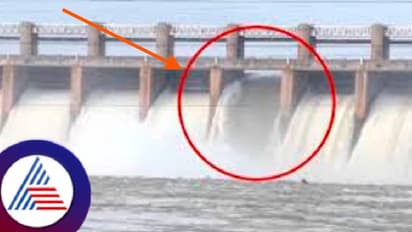Tungabhadra dam crisis puts Karnataka, Andhra & Telangana at flood risk; here's how crust gate broke

Synopsis
The Tungabhadra Reservoir's 19th crust gate failed, causing a significant water release and flood risk in Karnataka, Andhra Pradesh, and Telangana. Authorities are urgently releasing water and repairing the gate to prevent further damage. The incident highlights the need for immediate maintenance and dredging to restore the reservoir's safety and capacity.
The 19th crust gate of the Tungabhadra Reservoir, a critical lifeline for Karnataka, Andhra Pradesh, and Telangana, was washed away late Saturday night, causing widespread concern. This incident marks the first time in the dam's history that a crust gate has been broken and swept away, raising alarms across the region. The failure of the gate chain, which led to the gate being washed away, has forced authorities to release large volumes of water, posing a significant flood risk to downstream areas.
The disaster occurred when the chain that lifts the gate snapped, leading to the gate's collapse and causing 35,000 cusecs of water to gush out in a matter of minutes. This unprecedented situation has prompted the release of over one lakh cusecs of water from the dam to ensure the safety of the remaining structure.
Where is Tungabhadra Dam? 7 unique things to know about this Dam
Experts have emphasized the urgency of emptying nearly half of the reservoir's water, around 52 TMC (Thousand Million Cubic feet), to repair the damaged gate. This has led to increased water discharge into the river, raising concerns for residents in the river basin areas of Karnataka, Andhra Pradesh, and Telangana. Authorities have issued high-alert warnings to these communities, as there is a growing fear that the released water could inundate hundreds of acres of riverbed land in Koppal and Raichur districts.
The reservoir, which was filled only last month, had brought joy to the farmers and residents who rely on it. However, this joy turned to anxiety late on Saturday night when a loud noise was heard as the gate chain broke, causing a sudden and forceful release of water. The situation escalated as the dam began to vibrate under the pressure of the water escaping from the damaged gate.
In response to the crisis, the remaining 32 gates of the reservoir were opened to release water and prevent further damage. By Sunday night, more than one lakh cusecs of water were flowing into the river, leading to concerns that the sudden increase in water levels could threaten important historical monuments in Hampi.
Karnataka: Cauvery River flood waters submerge roads, buildings in Kodagu
Authorities have mobilized a team of technicians from Andhra Pradesh, Telangana, and Mumbai to undertake the repair of the broken gate using advanced international technology. The repair work is expected to take at least five days, but some sources suggest it could take up to ten days, depending on the complexity of the damage. In the meantime, efforts are underway to manage the situation by gradually releasing water to avoid a catastrophic flood.
Due to siltation, the reservoir, which has a total storage capacity of 133 TMC, can currently hold only 105 TMC of water.
Stay updated with the Breaking News Today and Latest News from across India and around the world. Get real-time updates, in-depth analysis, and comprehensive coverage of India News, World News, Indian Defence News, Kerala News, and Karnataka News. From politics to current affairs, follow every major story as it unfolds. Download the Asianet News Official App from the Android Play Store and iPhone App Store for accurate and timely news updates anytime, anywhere.